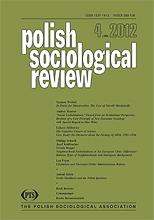Neighbourhood Embeddedness in Six European Cities:Differences Between Types of Nieghbourhoods and Immigrant Background
Neighbourhood Embeddedness in Six European Cities:Differences Between Types of Nieghbourhoods and Immigrant Background
Author(s): Philipp Schnell, Ursula Reeger, Josef KohlbacherSubject(s): Social Sciences
Published by: Polskie Towarzystwo Socjologiczne
Keywords: embeddedness; GEITONIES; immigrants; neighbourhood; social ties
Summary/Abstract: This paper analyses neighbourhood embeddedness of immigrant and non-immigrant populations in six European cities. We define neighbourhood embeddedness as an individual level concept and distinguish two main dimensions: place and network embeddedness. The neighbourhood embeddedness concept provides us with the possibility to study attitudinal and behavioural aspects of individuals related to the place of living. Using data from the 'Generating Interethnic Tolerance and Neighbourhood Integration in European Urban Spaces' (GEITONIES) project, we explore communalities and differences in the degree of embeddedness and its underlyingmechanisms for immigrant and non-immigrant residents across a set of different neighbourhood types. Our findings suggest that neighbourhoods are still important focal points of social life. But immigrants are characterized by higher levels of neighbourhood embeddedness than native residents which are mostly related to the strong link between perceived feelings of attachment to the people in the neighbourhood and the place as such.
Journal: Polish Sociological Review
- Issue Year: 180/2012
- Issue No: 4
- Page Range: 523-543
- Page Count: 20
- Language: English

